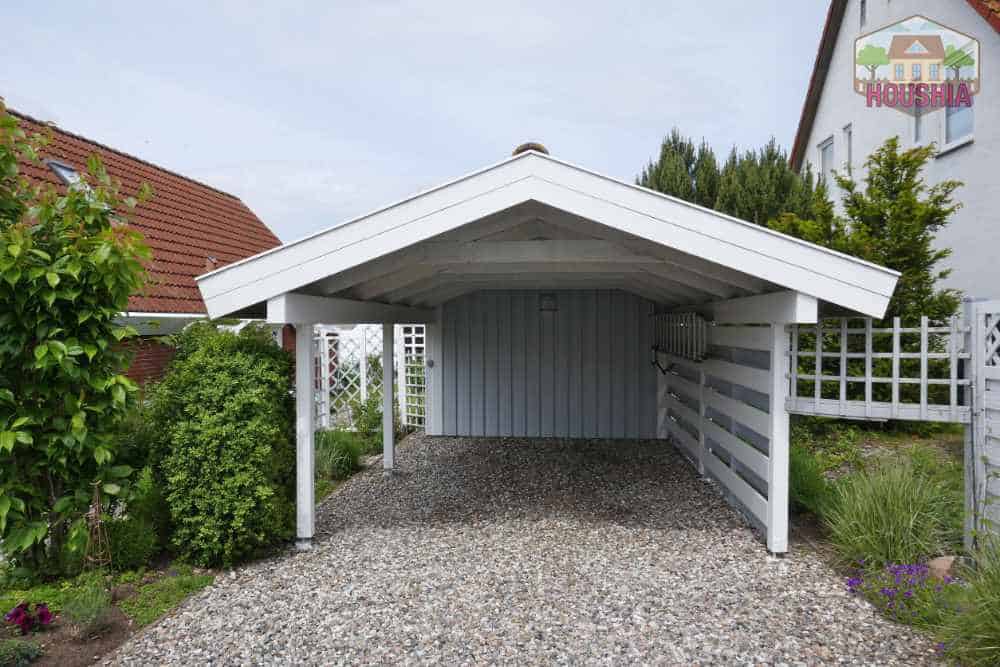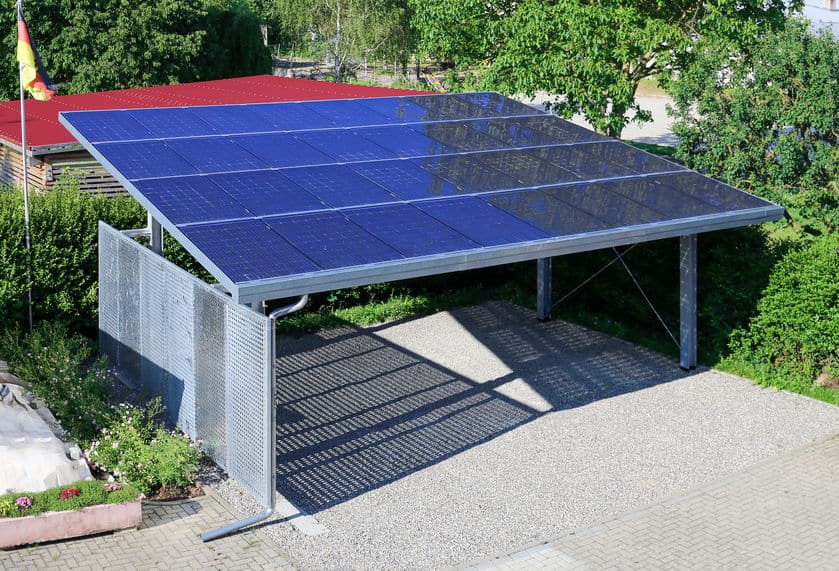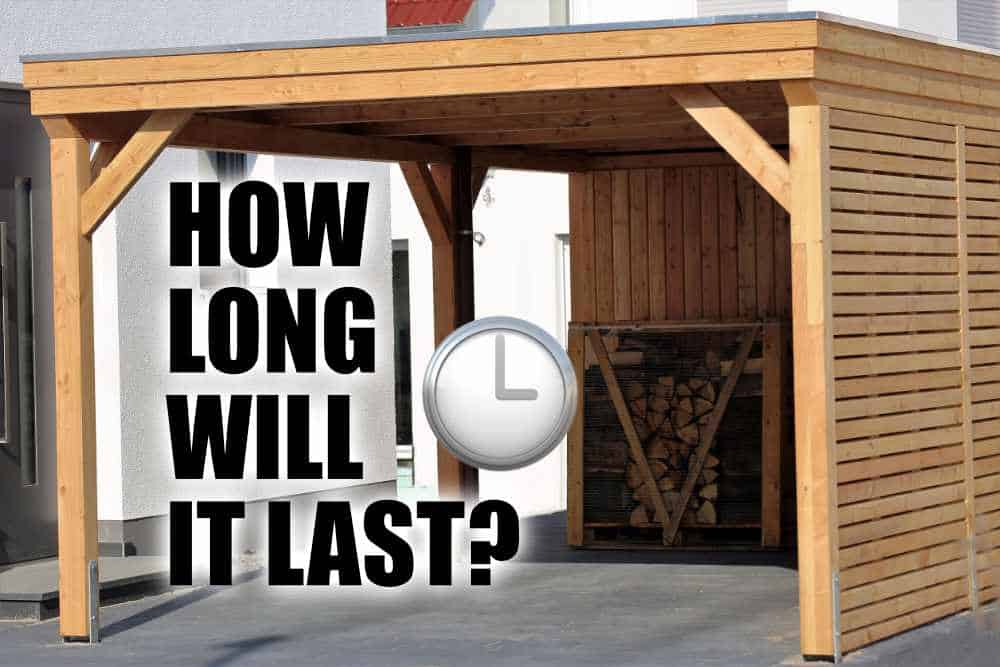Portable garages are a practical and affordable way to add extra outdoor storage or workspace to your home. While not as permanent as a regular garage, you may still wonder how long one might last before making the investment.
On average, portable garages can last up to 10 or more years if properly cared for, and factors such as weather, and the quality of the build and materials can cause this number to fluctuate.
Though a wise investment, portable garages can be pricey, so you will want to ask the right questions before making your purchase to ensure you will have the longest-lasting model for your needs and budget.
Read on to get a better idea of what kind of portable garage or carport is right for you.
Types of Carports and Their Lifespans
While the best carports can last more than ten years, not all will prove to be as long-lasting.
This can sometimes be due to the type of carport design. There are two main types of carports available on the market:
- Canopy
- Full enclosure
The full enclosure carports will function more like a garage in that they will give your belongings full protection from the elements and keep them out of view from the public.
A canopy carport will work better as a way to keep some of the elements, mainly sun, falling debris, and rain or snow, off of your car.
The canopy carport will be much cheaper, but more likely to buckle under the elements in as little as 2-3 years especially if the structure includes a polyethylene roof.
Your best bet for long-term investment will be a full enclosure carport with tough steel rods and either a polyethylene covering or full metal siding.
Does Your Climate Affect the Life of Your Carport?
Yes, climate does affect the lifespan of your carport, but it may come as a surprise that harsh winters are not the worst of your carport fears.
There are many factors to consider before deciding on a model such as UV and wind exposure, as well as snow load.
Climate may be one of the top considerations when deciding which type of carport is right for your space, as the elements are the number one cause for the deterioration in your carport’s lifespan.
Consider the following types of climates and the suggested carports for these areas.
Dry Climate
In a dry climate, your biggest enemy will be the sun. For those who live in this type of climate, it is recommended that you either invest in an all-metal carport or switch out a tarp every one to two years if you own a polyethylene model.
You may also be subject to sandy wind storms if you are located in the desert.
Consider a fully enclosed model to protect your car or items from accumulating sand damage, and look to the following suggestion for what to do in windy conditions.
Windy Climate
If you live in a place where there is a tornado season, or even where wind gusts are notoriously strong, you will want to make sure your carport is securely anchored into the ground to prevent the entire structure from rolling away, potentially bending metal poles, rendering the shelter useless.
A fully metal carport will be best for this type of climate, as these have the sturdiest roofs and can be the most securely anchored to the ground.
Also, consider anchoring your carport into asphalt or concrete. The greater the weight of the structure, the harder it will be to lift up and into the air.
Cold Climate
Carports are more popular in areas with heavy snowfall. No more waking up twenty minutes earlier to heat up your car and dust off the windshield.
However, snow can be harsh and heavy, and if your carport is not properly balanced, snow can build up and cause parts to cave-in.
Check to make sure that the carport you are interested in buying is rated for wind and snow. Most will provide an estimate as to how many pounds of snow the roof will be able to withstand.
Typically an all-metal carport will withstand the snow best, but a fully enclosed polyethylene carport with strong metal rods can also hold its own here.
How Can I Extend the Life of My Carport?

While investing in the sturdiest model and highest-grade materials for your carport will help to extend its lifespan, there are still some crucial factors to consider if you want to give your purchase the best shot at pulling through for the long haul.
The biggest considerations have to do with protecting your carport from the elements, mainly UV damage and wind.
Protecting Your Carport from UV Damage
One of the number one causes for a ruined polyethylene carport is UV damage. Even though the carports are coated to resist the sun’s rays, overtime that coating will be rubbed away by a variety of elements.
The best way to prevent this steady decline in the strength of the carport roof is to cover it with a tarp.
The tarp will only cost you around $50 and will typically last 1-2 years. You will need to anchor it down which can be done in a variety of ways, including:
- Tucking the tarp’s sides inwards and taping them to the structure of the carport.
- Threading rope through the tarp’s eyelets and then tying it down to anchors firmly planted in the ground.
Properly Anchoring Your Carport
Another elemental factor that leads to quick damage is strong winds. You will want to make sure your carport is anchored down, especially if you live in a windy area as mentioned above.
Some companies argue that their carports are only as strong as their anchors. You can anchor your carport down with any of the following:
- Rebar
- Concrete
- Asphalt
- Weights
- Water Ballasts
The way you anchor your carport into the ground will depend on what kind of surface you have built it on.
Laying a foundation for your carport will cost more, but it will greatly improve the overall stability of the structure and is strongly recommended, especially if you live in an area with harsh winters full of hail and snowstorms.
Which Types of Carports Last the Longest?

A fully metal carport will typically last the longest, though as mentioned above, it will only be as strong as its anchoring system.
Building a strong, typically concrete foundation for an all-metal carport will be the longest-lasting option.
While you can get away with cheaper carport models in mild climates, there are some that will withstand the harshest conditions longer than the rest.
Carports are typically made out of two types of materials:
- Polyethylene
- Metal
The metal is typically either aluminum, galvanized steel, or mixed with zinc alloy. These are made to resist the elements, including mold and UV rays.
Polyethylene can also be substituted with vinyl and is coated to prevent mold, mildew, and UV damage.
As for polyethylene carports, these can last up to ten years but will need more help over time. The biggest issue with this type of carport is a leak in the roof and you will need to buy a new tarp every so often to cover the top.
Shelterlogic and King Canopy are two companies that make excellent fully enclosed, polyethylene portable garages.
Conclusion
The bulk of the work and research needs to be done before purchasing and during installation in order to ensure the longevity of your portable garage or carport.
Save yourself time and money in the long run by investing in a model that fits your needs and taking care to securely anchor it into the ground.

